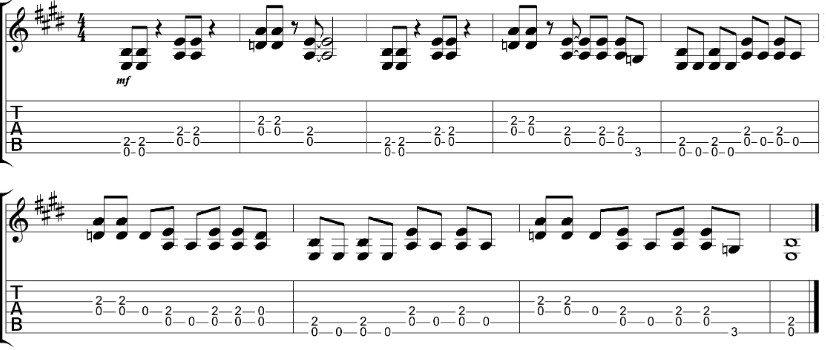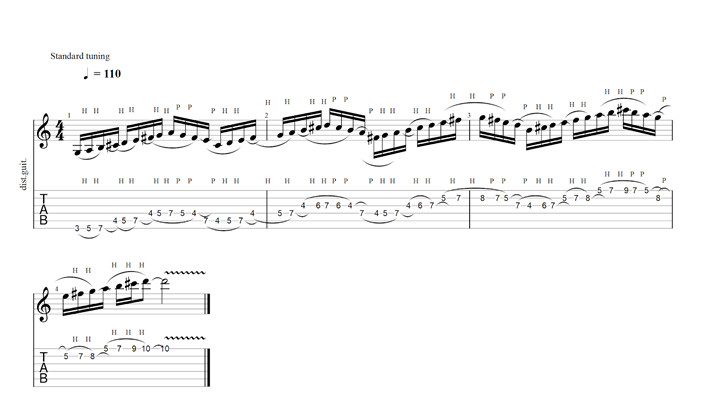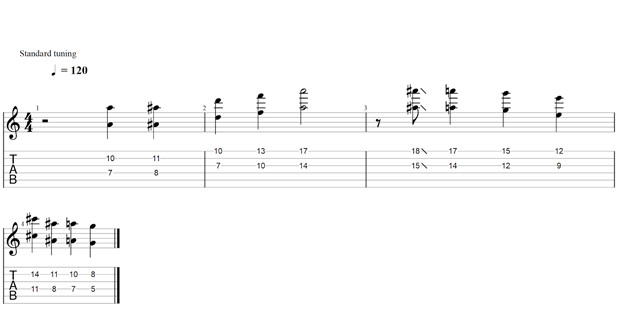Welcome back to guitarplayers.net! In today’s lesson, we’re diving into a topic that often confuses even seasoned guitarists: the difference between guitar riffs and Guitar Licks. Understanding guitar riffs and guitar licks is crucial for both composing original music and effectively communicating with fellow musicians. Many players struggle to define or differentiate these terms, which can lead to misunderstandings and hinder musical creativity.
If you’ve ever felt unsure about what sets a riff apart from a lick, you’re definitely not alone. This article will clarify these concepts, providing you with a solid foundation to enhance your guitar playing and musical vocabulary. Let’s clear up the confusion and explore the essential world of guitar riffs and guitar licks.
 Close-up of guitar fretboard with fingers playing chords, suitable for illustrating guitar riffs and licks.
Close-up of guitar fretboard with fingers playing chords, suitable for illustrating guitar riffs and licks.
Throughout this guide, we’ll reference iconic guitar riffs and guitar licks, and we’ll even provide tablature examples to help you learn and play them yourself. To truly grasp the essence of each example, we highly recommend listening to recordings and watching videos of the original songs. This will allow you to appreciate the nuances and stylistic context of both guitar riffs and guitar licks in action.
So, let’s embark on this musical journey and finally unravel the mystery surrounding guitar riffs and guitar licks.
What Exactly is a Guitar Riff?
Let’s cut straight to the chase: a guitar riff is the backbone of a song. It’s a short, repeated musical phrase or motif that serves as the signature identity of a song. Think of it as the central musical idea, often introduced at the beginning of a track, that immediately grabs the listener’s attention and sets the song’s overall tone.
Remember the legendary intro to Guns N’ Roses’ “Sweet Child O’ Mine”? That’s a quintessential guitar riff. It’s instantly recognizable and as iconic as the song itself, becoming one of the most famous musical phrases in guitar history. That’s the power of a great guitar riff.
 Angus Young of AC/DC playing guitar with a focused expression, representing iconic guitar riff musicians.
Angus Young of AC/DC playing guitar with a focused expression, representing iconic guitar riff musicians.
The Importance of Guitar Riffs
A well-crafted guitar riff elevates a simple song, making it unforgettable. This core musical theme remains consistent throughout the song, acting as a musical anchor that listeners immediately recognize and connect with.
Imagine “Stairway to Heaven” by Led Zeppelin without its enchanting opening riff. It simply wouldn’t be the same. The intro riff is the very soul of that song, setting the mood and building anticipation. Similarly, removing the heavy, driving riff from Deep Purple’s “Smoke on the Water” would instantly strip the song of its power and impact.
Countless guitarists have harnessed their creativity to forge guitar riffs that have not only topped charts but have also become timeless classics, resonating with audiences for decades.
Essential Guitar Riffs to Explore
Here are some prime examples of legendary guitar riffs that every guitarist should know (we’ll explore more later in this article):
- “Voodoo Child (Slight Return)” – Jimi Hendrix
- “Beat It” – Michael Jackson (featuring Eddie Van Halen)
- “Alphabet Street” – Prince
- “No One Knows” – Queens of the Stone Age
- “Killing in the Name” – Rage Against the Machine
- “(I Can’t Get No) Satisfaction” – The Rolling Stones
- “Seven Nation Army” – The White Stripes
- “Hero” – Skillet
Guitar Riffs: The Heart of a Song
Hopefully, you now have a clear understanding of what a guitar riff is. It’s the musical heart and soul of a song, establishing a thematic foundation, most frequently found in the song’s introduction, though not exclusively.
Feel free to experiment and compose your own guitar riffs, placing them wherever you feel they best enhance your music. The key is that a riff should be a concise and memorable musical phrase that defines your song or elevates it to another level.
There’s no need to improvise on a guitar riff; its strength lies in its consistent and recognizable nature. No one would suggest altering the iconic riff of “Voodoo Child,” because its power is in its familiarity and impact.
Now, let’s shift our focus to guitar licks and uncover how they differ from guitar riffs.
Unpacking the Guitar Lick
No, we’re not talking about literally licking your guitar like some rockstars do on stage! While that might be a memorable stage move, it has nothing to do with the musical definition of a guitar lick.
Unlike a guitar riff, which remains constant and plays a vital role in establishing a song’s main musical theme, a guitar lick is a short, melodic phrase, often improvised or pre-composed, used to add flair and interest to a solo or fill in musical gaps. Guitar licks are all about variation and embellishment.
Guitar licks can go by various names, including guitar solos, fills, runs, and phrases. Regardless of the terminology, the core idea is that a lick is meant to be adaptable and provide a moment of instrumental expression within a song.
 Close-up shot of guitar player's hand on the fretboard during a solo, highlighting the improvisational nature of guitar licks.
Close-up shot of guitar player's hand on the fretboard during a solo, highlighting the improvisational nature of guitar licks.
The Purpose of Guitar Licks
Guitarists often use licks to inject individuality and excitement, especially during guitar solos. This is particularly true during live performances where engaging the audience is key.
Guitarists might modify existing solos, introduce new flourishes, or insert short, catchy phrases. These spontaneous musical ideas are essentially improvisational guitar licks.
However, it’s important to note that not every improvisation qualifies as a guitar lick. A true guitar lick is designed to be reusable, a musical idea that can be incorporated in different ways across multiple songs or performances.
A guitarist might alter a lick by adding or removing notes, changing the rhythm, or modifying other aspects. Because licks are structured and have a defined musical idea, they are learnable and can be incorporated into your playing to add extra dynamism to your solos and fills. Mastering a repertoire of guitar licks can significantly enhance your improvisational skills and overall guitar vocabulary.
In the following sections, we’ll examine classic examples of both guitar licks and guitar riffs to further illustrate their differences and how they are employed in music. Remember the fundamental distinction: guitar riffs are generally fixed and repetitive, while guitar licks are designed for variation and improvisation.
Key Differences Between Guitar Riffs and Guitar Licks
To solidify your understanding, let’s reiterate the core differences between guitar riffs and guitar licks, especially if you jumped straight to this section.
As we’ve established, a guitar riff is a distinct, repeated, and attention-grabbing musical phrase. It captivates listeners through its rhythm, melody, or harmonic structure, often defining the character of a song.
Guitar riffs can be strategically placed throughout a song, but they are most commonly featured in the introduction, immediately setting the song’s atmosphere.
When effectively crafted, a guitar riff becomes a memorable musical hook that resonates with the audience almost instantly.
On the other hand, a guitar lick is a musical phrase used by guitarists to embellish and vary a small section of a song, often during solos or fills.
 Infographic comparing Guitar Riffs and Guitar Licks with bullet points and contrasting imagery.
Infographic comparing Guitar Riffs and Guitar Licks with bullet points and contrasting imagery.
A guitar riff stands alone as a complete musical statement. Playing the intro riff of Metallica’s “Nothing Else Matters” is musically satisfying even in isolation. The same cannot be said for a guitar lick. A guitar lick played in isolation would sound incomplete, abrupt, and lack context.
While a guitar riff can be adapted and played on various instruments, a guitar lick is inherently guitar-centric, emphasizing techniques and styles specific to the instrument. A guitar riff sets the overall vibe, whereas a guitar lick is used to showcase a guitarist’s skill and add expressive flourishes. Unlike riffs, guitar licks are the building blocks of guitar solos and improvisations, allowing for spontaneous melodic exploration within a song’s framework.
While guitar riffs are designed to be enduring and memorable, guitar licks may not always have the same lasting impact as they are often more fleeting and contextual.
Analogy: Think of baking a cake. The icing is like the guitar riff – it defines the cake’s appearance and initial impression, making it unique and essential to the overall experience. Guitar licks, in this analogy, are like sprinkles or other small decorations – not crucial to the cake’s fundamental flavor or design, but they add interest and a touch of flair.
The most significant difference remains improvisation. Guitar licks are inherently improvisational and adaptable, while guitar riffs are typically composed as part of the song’s structure and are rarely improvised.
Guitar Riffs vs. Licks: A Quick Comparison
| Feature | Guitar Riff | Guitar Lick |
|---|---|---|
| Purpose | Defines song identity, sets musical theme | Adds flair, embellishment, improvisational element |
| Repetition | Repeated consistently | Varied and adaptable |
| Placement | Often in intro, but can be anywhere | Primarily in solos, fills, and improvisations |
| Completeness | Complete musical idea on its own | Incomplete in isolation, needs context |
| Instrumentation | Adaptable to various instruments | Guitar-specific techniques and style |
| Memorability | Designed to be highly memorable and iconic | Can be memorable, but often more contextual |
| Improvisation | Generally not improvised, part of composition | Often improvised or adapted in performance |
15 Unforgettable Guitar Riffs You Need to Hear
Earlier, we touched upon some iconic guitar riffs. Now, let’s expand that list with more exceptional examples that every aspiring guitarist should explore for inspiration and musical education.
Many of these riffs are consistently ranked among the greatest guitar riffs of all time, and for good reason. Immerse yourself in these riffs to understand their power and impact.
Try listening to each song and then mentally removing the guitar riff. This exercise will highlight just how crucial the guitar riff is to the song’s identity and overall impact. Prepare to discover some new additions to your playlist!
 A collage of album covers featuring bands known for iconic guitar riffs, like Nirvana, AC/DC, and Black Sabbath.
A collage of album covers featuring bands known for iconic guitar riffs, like Nirvana, AC/DC, and Black Sabbath.
Note: This list is presented in no particular order.
- “Brianstorm” – Arctic Monkeys
- “Johnny B. Goode” – Chuck Berry
- “Paranoid” – Black Sabbath
- “Sunshine of Your Love” – Cream
- “One” – Metallica
- “Back in Black” – AC/DC (often cited as the greatest guitar riff of all time)
- “Pretty Vacant” – Sex Pistols
- “I Wanna Be Your Dog” – The Stooges
- “I Can’t Explain” – The Who
- “Cinnamon Girl” – Neil Young
- “Don’t Cry” – Guns N’ Roses
- “Marquee Moon” – Television
- “Get It On” – T. Rex
- “Alive” – Pearl Jam
- “Smells Like Teen Spirit” – Nirvana
Beginner-Friendly Guitar Riffs to Learn at Home
Now it’s your turn to pick up your guitar and put theory into practice! In this section, we’ll explore a selection of guitar riffs that are perfect for beginners to learn, practice, and master.
These riffs are designed to be accessible to players at any level, provided you have a basic understanding of guitar fundamentals. Feel free to experiment with these riffs, incorporate them into your own songs, or modify them to suit your personal style.
 Acoustic guitar leaning against a chair in a cozy setting, inviting practice and guitar learning.
Acoustic guitar leaning against a chair in a cozy setting, inviting practice and guitar learning.
Power Chord Guitar Riff for Beginners
This versatile guitar riff utilizes power chords and can be adapted in various ways. It’s an excellent riff pattern for practice and can be integrated into original songs, perhaps with slight modifications to make it your own. Palm muting can enhance the heaviness and impact of this riff. (If you’re unfamiliar with palm muting, numerous online tutorials can guide you).
 Guitar tab for a beginner-friendly power chord riff in E5, A5, and D5.
Guitar tab for a beginner-friendly power chord riff in E5, A5, and D5.
This riff uses E5, A5, and D5 power chords. Try incorporating this riff into the chorus of a song, ensuring it complements the overall chord progression and feel of the chorus.
Funky Clean Guitar Riff for Practice
Funky guitar riffs are universally appealing and a fantastic addition to any guitarist’s repertoire. This riff provides a great starting point for exploring funky rhythms and clean tones. As with the other examples, feel free to modify this riff to create variations that resonate with your musical taste.
For this riff, consider experimenting with using your neck-hand thumb to fret the lower string notes. This technique is efficient for funky rhythms and allows for convenient muting effects. This riff pattern is well-suited for verses in a song, creating a groove that drives the rhythm.
 Guitar tab for a funky clean guitar riff pattern.
Guitar tab for a funky clean guitar riff pattern.
Try transposing this riff to G for subsequent bars to create variation and movement. These patterns can be used throughout verses and adapted as needed to fit the song’s structure.
Beginner Acoustic Guitar Riff
Acoustic guitarists, we haven’t forgotten you! There’s a wealth of incredible acoustic guitar riffs to explore.
Here’s an example of a captivating acoustic guitar riff for you to practice. This riff is designed to be used once in the introduction of a song. Despite its brevity, this riff effectively establishes the song’s tone and tempo, creating an engaging opening.
Guitar Licks to Explore at Home
Of course, where there are guitar riffs, there must be guitar licks! Let’s delve into some guitar licks that are worth learning and practicing to expand your guitar vocabulary.
Guitar Lick in the Style of Joe Satriani
When discussing guitar licks, Joe Satriani’s name inevitably arises, and for good reason. He is widely regarded as one of the most technically proficient and expressive guitarists. His performance, precision, compositional style, and dynamic stage presence are inspiring and a valuable style to emulate.
Here’s a guitar lick inspired by Satriani’s playing. It incorporates some of his signature techniques and stylistic elements, and it might be slightly more challenging than the previous riff examples. Don’t be discouraged! With dedicated practice, you can master these techniques and add Satriani-esque flair to your playing.
 Guitar tab for a guitar lick in the style of Joe Satriani, showcasing advanced techniques.
Guitar tab for a guitar lick in the style of Joe Satriani, showcasing advanced techniques.
Guitar Lick in the Style of Wes Montgomery
Wes Montgomery, a true jazz guitar innovator. If you’re unfamiliar with his work, discovering Wes Montgomery is essential for any serious guitarist. To give you a taste of his brilliance, here’s a guitar lick inspired by his signature techniques and improvisational approach.
 Guitar tab for a guitar lick in the style of Wes Montgomery, highlighting jazz guitar phrasing.
Guitar tab for a guitar lick in the style of Wes Montgomery, highlighting jazz guitar phrasing.
Concluding Thoughts: Embrace Riffs and Licks
After experimenting with these tabs and exploring the world of guitar riffs and guitar licks, you’re well-equipped to continue your musical journey.
To further support your growth as a guitarist, I’ve written a comprehensive book that delves deeper into guitar techniques, guitar licks, guitar riffs, and much more.
If you’re interested in expanding your guitar skills, “Soloing Techniques For Beginners” is an excellent resource for your next steps.
Featuring over 100 guitar licks and guitar riffs, many inspired by legendary guitarists, this book offers months of engaging practice material while accelerating your guitar playing progress.
Take the next step in your guitar journey and shop now!
[


